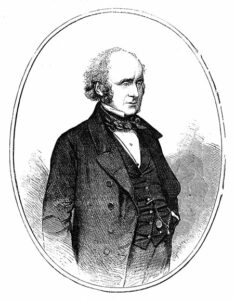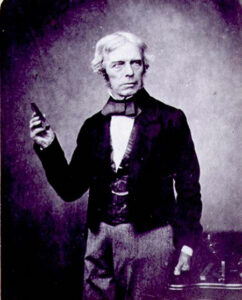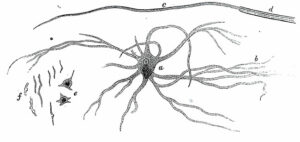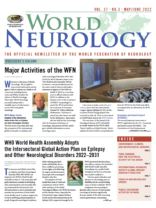By Edward Reynolds
Electrical concepts of brain activity became widely established in neurology and psychiatry in the 1930s following the discovery of the human electro-encephalograph by Hans Berger (1873-1941) in the 1920s. However, such concepts were first formulated and confirmed almost a century earlier in the 1840s by Robert Bentley Todd (1809-1860), influenced by his contemporary in London, Michael Faraday (1791-1867), who at that time was laying the foundations of our modern understanding of the interchangeable polar forces of electricity and magnetism.
Robert Bentley Todd

Robert Bentley Todd (1809-1860)
Todd was born in Dublin, the second son of a large and distinguished Anglo-Irish family, whose father, Charles Hawkes Todd, was professor of anatomy and surgery at the Royal College of Surgeons in Ireland of which he was also president in 1821. He trained in Medicine at Trinity College and the Richmond Hospital, where he was influenced by Robert Graves (1796-1853). He qualified at his father’s college in 1831 and immediately proceeded to England where in 1833 he was awarded a BM by Oxford University. In 1836, at the remarkable age of 27 years, he was appointed to the chair of physiology and morbid anatomy at King’s College in London. Todd was the prime mover in founding King’s College Hospital in 1840 where he became its most eminent physician. He was a gifted teacher and administrator who transformed the fortunes of the Medical School of which he became the first dean in 1842. His lectures on physiology were the first of their kind in the U.K. and prompted other medical schools to emulate. By 1838, he was already elected a Fellow of the Royal College of Physicians and the Royal Society in London.
As a scientific physician, Todd made several contributions to the understanding and treatment of infectious, gastro-intestinal, and rheumatic diseases, but his main interest was always the nervous system. His many outstanding observations in neuroanatomy, neurohistology, neurophysiology, neuropathology, and clinical neurology are described in several major works. He was the first to identify the functions of the posterior columns of the spinal cord and to separate spinal ataxia from spinal paraplegia. Gowers credits Todd with the first exact account of locomotor ataxia or tabes dorsalis and “if any name is attached to it, that of Todd alone can be right.” His clinical lectures on paralysis, based on the clinical and pathological study of 83 cases, are a milestone in the history of stroke. They include the first description of transient post-ictal paralysis, which a generation later John Hughlings-Jackson (1835-1911) referred to as “Todd’s Paralysis” and for which Todd is perhaps best remembered today, although it is a small part of his contribution to neurology. He also distinguished the “irritating” (epileptic) from the “paralyzing” phenomena of cerebral lesions, which are now associated with the later similar concepts of Jackson who used the words “discharging” and “destroying.”
Michael Faraday

Michael Faraday (1791-1867)
Michael Faraday was born in London into a poor blacksmith’s family. He had little education but, as an apprentice bookbinder, he devoured the scientific books he was binding. Through his own initiative and good fortune, he was appointed in 1813 as a laboratory technician to Sir Humphrey Davy (1778-1829), professor of chemistry and director at the Royal Institution in Albemarle St., London, close to King’s College in the Strand. Among Davy’s important achievements, he discovered sodium, potassium, chlorine, calcium, and magnesium, using the Voltaic Pile. Faraday remained at the Royal Institution for more than 50 years, rising to surpass Davy and to become one of the greatest experimental philosophers of all time. The practical consequences of his discoveries have profoundly influenced the nature of civilized life.
Faraday studied all forms of electricity: voltaic, common, magneto, thermo, and so-called “animal” electricity, and considered that the various types were fundamentally the same. He examined the inter-conversion of energies, not only electricity and magnetism, but also light, heat, and gravity, which was the basis for the later law of the conservation of energy. His meticulous diaries record that on Oct. 22, 1838, Todd was present during his experiments on the “animal” electricity generated by the electric eel (Gymnotus). Also present on that occasion were two of Todd’s distinguished colleagues from King’s College: Prof. John Frederick Daniell (1790-1845), who was the first professor of chemistry (1831-1845) and invented the first constant cell battery (the Daniell battery) and Prof. Charles Wheatstone (1802-1875), who was the first professor of experimental philosophy (1834-1875) and developed the first electric telegraph. Both were good friends of Faraday, sharing a common interest in electricity, and no doubt they introduced him to Todd, their new, young technical scientific colleague.
The Electrical Basis of Nerve Conduction and Brain Activity

A central nervous system “vesicle” and related “fibers” (neurone in later terminology). From Todd R.B. and Bowman W. The physiological anatomy and physiology of man – Volume 1, Parker, London, 1845
Todd applied the electrical concepts of Faraday to nervous conduction and to brain activity, especially epilepsy. He wrote: “Adopting the language of the illustrious Faraday which expressed with clearness and precision the fundamental phenomena of the electric force, we may call the nervous power a polar force, generated in the centres and propagated by the rapid polarization of the neighboring particles in various directions.”
With his junior colleague William Bowman (1816-1872), Todd was a pioneering microscopist and neurohistologist. He was the first in the U.K. to apply Schwann’s (1839) cell theory to the nervous system. He recognized that the “vesicles” he observed corresponded to Schwann’s cell bodies. Furthermore, the vesicles had one or several nerve fibers (later called axons) connected to them and that every nerve fiber was connected to a vesicle which was the point of departure for one or many fibers. He brilliantly foresaw that each nerve vesicle and its associated fibers, i.e. neurone in later terminology, was a distinct apparatus for the generation and propagation of “nervous polarity.” Todd was unquestionably the first to develop the concept of nervous polarity to explain nerve cell conduction, facilitated by the insulating properties of Schwann’s white matter (myelin). In the process, he introduced the concept of “afferent” and “efferent” into neuroscience to explain the direction of conduction. These were the foundation stones of what decades later became known as the “neurone doctrine.”
The Electrical Basis of Epilepsy
In his 1849 Lumleian Lectures to the Royal College of Physicians, Todd discarded current vascular or inflammatory theories of epilepsy and developed a radically new electrical theory based on his new understanding of nervous polarity, influenced by Faraday’s concepts of the interchangeable polar forces of electricity and magnetism. He had learned from Faraday how a rise in electrical tension could, at a certain threshold, result in a sudden change in polar state, like the spark from a battery or lightning. Todd conceived of epilepsy as “periodical evolutions of the nervous force comparable to the electrical phenomena described by Faraday under the name of ‘disruptive discharge’.” In convulsions, he envisaged the polar tension in the grey vesicular matter of the hemispheres and mesocephale rising to the highest degree and a rapid discharge taking place “exciting the other parts of the brain and spinal cord with all the violence of the discharge from a highly charged Leyden Jar.”
Todd investigated and confirmed his theory in rabbits utilizing galvanic stimulation with a magnetoelectric machine designed by Faraday. Tonic-clonic seizures were elicited by stimulation of the mesocephale and corpora quadrigemina. Stimulation of the spinal cord and medulla elicited tetanic muscular phenomena. The loss of consciousness in epilepsy he attributed to the involvement of the highest hemispheric vesicular grey matter. It was not until 20 years later that Fritsch and Hitzig discovered the motor cortex in electrical stimulation experiments in dogs, but Todd was aware that superficial tuberculous or syphilitic lesions of the human cortex could result in unilateral motor convulsions in the limbs on the opposite side of the body. He stated: “Hence, we must not deny to these hemispheric lobes a certain power of exciting motion either directly or indirectly through their influence on other ganglia of the brain.”
Subsequent Developments
Electrical concepts of brain activity were not widely accepted until the discovery of the human EEG by Berger in the 1920s although further hints can be traced to the cortical stimulation experiments of Gustav Fritsch (1838-1927) and Eduard Hitzig (1839-1907) and of David Ferrier (1843-1928), and also the evoked potential studies of Richard Caton (1842-1926), all in the 1870s. Epilepsy continued to be widely viewed as a disorder of the cerebral circulation until the 1930s, when EEG studies confirmed the concept of electrical discharges in seizures of different types.
By then, Todd’s studies, concepts, and priority had been forgotten. Some retrospectively gave credit to Jackson for his concept of “discharges of grey matter,” but Jackson never acknowledged Todd’s priority even in his own Lumleian Lectures on the same topic of epilepsy a generation later in 1890. The philosophical Jackson admitted he had no knowledge of physics, and he tended to rely on Ferrier on scientific matters. It is unlikely that the neurophysiologist Ferrier was unaware of Todd’s priority as he worked at the same King’s College Hospital and regularly passed Todd’s statue in the lobby of the hospital.
In 1906, Santiago Ramón y Cajal (1852-1934) and Camillo Golgi (1843-1926) received the Nobel prize for their contribution to the “neurone doctrine,” the foundations of which were already laid by Todd but not acknowledged. In 1963, Alan Hodgkin (1914-1998) and Andrew Fielding Huxley (1917-2012) received the Nobel prize for identifying the ionic basis of Todd’s nervous polarity. Interestingly, the theory involved the same ions that Faraday’s mentor, Sir Humphrey Davy, had discovered, i.e. sodium, potassium, chlorine, calcium, and magnesium. The table illustrates the progression over a century and a half of our knowledge of brain electricity or nervous polarity from Davy’s discovery of the appropriate ions through the work of his pupil Faraday, who so profoundly influenced his clinical and scientific contemporary in London, Todd, down to the discovery of the ionic basis of neurotransmission by Hodgkin and Huxley.
Conclusion
Todd died in 1860, the same year as the foundation of the National Hospital for the Paralysed and Epileptic in Queen Square, a short walk from the first King’s College Hospital founded by Todd. His colleagues were so impressed with his many achievements that they commissioned a statue which stands today outside the third King’s College Hospital on Denmark Hill, South London. This was in recognition of his contribution to King’s College, to the hospital, to clinical and scientific medicine, including paralysis, and to medical and nursing education. What is not mentioned and was little understood at the time was his contribution to neuroscience, especially the electrical basis of nerve conduction and brain activity, and its application to neurology, especially epilepsy, influenced by his contact with and understanding of the scientific achievements of Faraday. Todd was so far ahead of his time that many of his neuroscientific achievements were overlooked, soon forgotten and credited to others, but now deserve greater recognition by historians of neuroscience and neurology. •
Edward H. Reynolds MD, FRCP, FRCPsych, works in the Department of Clinical Neurosciences at King’s College, London, U.K.
References
Binder/ DK, Rajneesh/ KF, Lee/ DJ, Reynolds E.H, Robert Bentley Todd’s contribution to cell theory and the neuron doctrine. Journal of the History of the Neurosciences 2011;20:123-134
Reynolds E.H. Todd, Faraday and the electrical basis of brain activity. Lancet Neurology 2004;3: 557-563
Reynolds E.H. Jackson, Todd and the concept of ‘discharge’ in epilepsy. Epilepsia 2007;48:2016-2022
Reynolds E.H. Robert Bentley Todd. In: Pioneers of Irish Neuroscience: a history of brain science in Ireland. Eds: Kelly A, Zarka Z, Roche R. Lettertec Publishing, Cork, 2022, pp47-51
